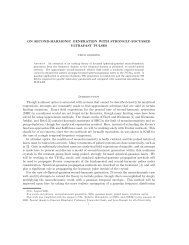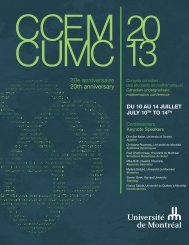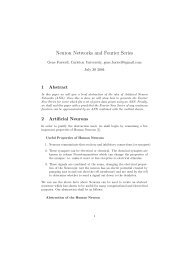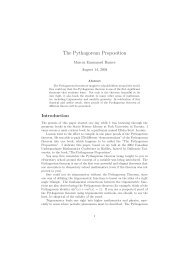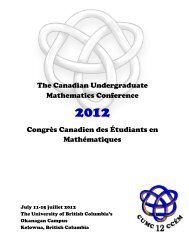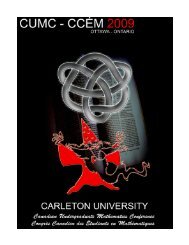booklet - CUMC - Canadian Mathematical Society
booklet - CUMC - Canadian Mathematical Society
booklet - CUMC - Canadian Mathematical Society
Create successful ePaper yourself
Turn your PDF publications into a flip-book with our unique Google optimized e-Paper software.
DATA MINING AND WHAT HAS EVERY ATHLETE PAYING ATTENTION TO THE GEEKSSTEVEN WUMoneyball, both the novel released in 2003 and the film in 2011, popularized a practiceincepted in the 70’s of using analytics within the sports industry to produce newobjective information that illuminates beyond the traditional box score. The intersectionsbetween sports statistics and recent buzzwords "big data" and "data science" areintroducing novel research that is positioning us in the midst of an interesting powerstruggle between traditional schools of thought and this new wave of innovation. Aftera brief overview on the major contributors to our topic’s history, I will introduce newtechnologies in the field, highlighting research presented at the MIT Sloan Sports AnalyticsConference that is applying a variety of data mining techniques from as wideas optical tracking to facial recognition software. To conclude, I will share findingsfrom my group data mining research project on Brian Burke’s publicly available playby-playNFL data for the 2002-2012 seasons and show how easy it is to join in on thetrend.SOLVING MATHEMATICAL PROGRAMS WITH EQUILIBRIUM CONSTRAINTS VIA GE-NETIC ALGORITHMSUKHREET SANDHUThe main goal of our presentation is to solve the MPEC (mathematical programswith equilibrium constraints) using Genetic Algorithm. In this talk, we see how aMPEC can first be reformulated as an equivalent one level non-smooth optimizationproblem and then this non-smooth optimization can be converted into a sequence ofsmooth optimization problems that will be solved using Genetic Algorithm and standardavailable software for constrained optimization. Moreover, we illustrate the viabilityand usefulness of the proposed approach by giving some computational resultsfor both academic and practical problems.INTRODUCTION TO STOCHASTIC PROGRAMMINGSVYATOSLAV GLAZYRINReal world optimization problems almost always include parameters that are notknown with certainty. Stochastic programming is a framework for modeling such problems,with the generic assumption that probability distributions governing the data areknown or can be estimated. Such models arise in many practical problems, rangingfrom investment portfolio optimization and asset management to planning, schedulingand control of electric power systems. My presentation will introduce the basics ofthis framework, along with several modelling and computation examples.EIGENVALUES OF GRAPHSTARA PETRIEFor any finite graph we can associate an infinite collection of real symmetric matricesindexed by the vertices of the graph. Once one obtains a matrix, it is natural toconsider the eigenvalues of these matrices. For any graph G, we let q(G) denote the47



